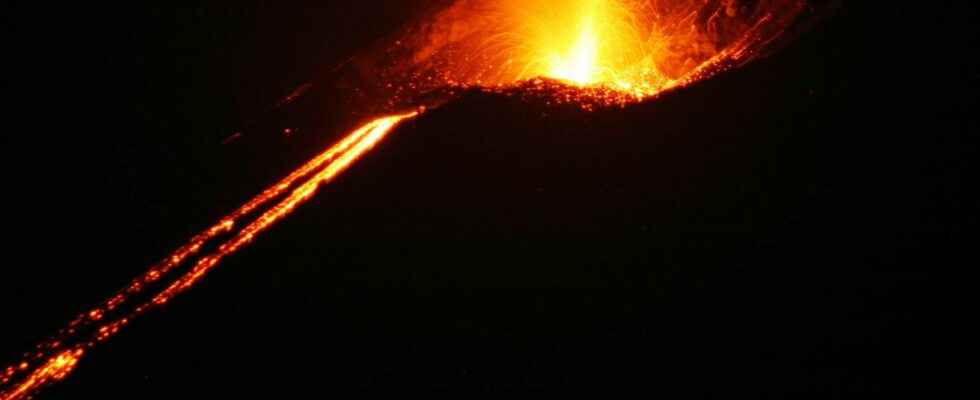You will also be interested
[EN VIDÉO] Geology of volcanic systems – an invitation to travel Interviews dating from 2009 with Georges Boudon, physicist at the IPGP, and members of the team studying the functioning of volcanoes, from the generation of magmas to eruptions. The vocation of IPGP films is to open the doors of laboratories and to accompany scientists in the world of geosciences. This film is part of a series of 14 short format films which are an invitation to travel from the cosmos to the center of the Earth. Design & production: Medi@terre, IPGP – 2009
On December 22, 2018, the Anak Krakatoa, located off the islands of Java and Sumatra, was entering a violent phase eruptive. This startle of activity had been accompanied by a collapse from one side of the volcano, generating a devastating tsunami which had hit the Indonesian coasts. This disaster left more than 400 dead and 14,000 injured. Not to mention the very significant material damage.
A family of very destructive volcanoes
In this sense, the 2018 eruption was one of the most devastating in recent history and scientists continue to study the mechanisms that led to this disaster and why it was so violent. However, the region is accustomed to volcanic eruptions with over 100 active volcanoes. It goes without saying, however, that the Anak Krakatoa carries on his shoulders a murderous geological history. The “son of Krakatoa” is indeed the descendant of one of the most dangerous volcanoes in human history. In 1883, Krakatoa explosion indeed caused a gigantic tsunami, with a high wave of more than 8 floors, resulting in the death of 36,000 people on the surrounding islands. Anak Krakatoa then gradually formed on the remains of the decapitated volcano, through multiple less devastating eruptions. Until 2018.
Six months before the eruption, Anak Krakatoa began to shake gently, producing small eruptions that did not worry the population. However, the situation changed abruptly on the evening of December 22, when a major landslide occurred on one of the flanks. This huge mass of magmatic debris collapsed into the ocean, initiating the devastating tsunami wave. Immediately afterwards, the activity of the volcano intensified in a phase of violent explosiveness.
Which came first: the eruption or the collapse?
Soon after the eruption, scientists went there to study and understand the chain of events that led to this disaster. In particular, they noticed that the tephra formed just after the landslide contained much smaller crystals than those formed before the collapse of the flank of the volcano. By combining this information with other observations, the scientists concluded that the collapse was a result of volcanic activity and that this event acted as a pressure relief valve, allowing the abrupt release of the pressure inside the magmatic conduits. By rapidly pouring out of the volcano through this new vent, the magma would have cooled rapidly, resulting in the formation of very small crystals.
At first, the researchers therefore thought that the eruption was the cause of the collapse. A classic pattern and observed on many volcanoes. This is particularly what happened during the eruption of Mount Saint Helens, in 1980. But new investigations, carried out by the same scientists, came to contradict this sequence. It appears that the data are best explained by an inverse process. It would therefore be the landslide that caused the eruption. There would thus not have been, prior to the collapse, significant change in magmatic dynamics. The collapse is believed to have resulted from the increasing instability of the volcano’s flanks in the face of increasing edifice. It is the sudden discharge linked to the landslide that would have disturbed the magmatic system, causing the volcano to switch into a phase of high intensity.
This change of point of view is important since it makes it possible to consider the establishment of a tsunami warning system by monitoring the volcanic edifice and identifying areas subject to instability. The study, published in Earth and Planetary Science Lettersshows the fine balance that exists between the load exerted by the volcanic edifice and the dynamics of the magmatic reservoir at depth.
Support an editorial team committed to popularizing science on Patreon!
Our mission ? Return the knowledge accessible to everyone.
We produce our own articles, investigations and reports every day, all on a human scale. Support us in this approach and this ambition.
Subscribe to Futura on Patreon!
Two subscription plans are offered to you with the following advantages:
- ” Futura ad-free »: get guaranteed ad-free access to the entire site for €3.29/month (+VAT).
- ” I participate in the life of Futura »: in addition to access without advertising, take part in the life of our independent media (votes, new content, surveys, etc.) for €6.29/month (+VAT).
Interested in what you just read?
